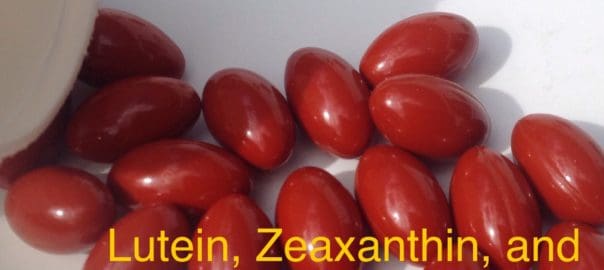Studies have shown that it is not just lutein and zeaxanthin that provide support to the retina, but there is a third carotenoid, meso-zeaxanthin that needs to be present for optimum anti-oxidant effect.
Lutein, zeaxanthin, and meso-zeaxanthin are characterized as he yellow pigment concentrated in the macula of the retina and collectively are called macular pigment. They provide protection, by the absorption of blue light and anti-oxidant activity, and thereby aid in the protection and function of the macula.
Studies have shown that there is a drop in macular pigment decades before the onset of macular degeneration. Those studies where participants took lutein and zeaxanthin experienced an increase in the vital macular pigment. Those who also supplemented with meso-zeaxanthin saw an even greater increase in macular pigment, more so than those who did hot supplement with meso-zeaxanthin. (Ref: Lutein, Zeaxanthin and Meso-zeaxanthin Supplementation….)
There is a bonus to supplementing with the carotenoids; multiple studies have found that test subjects who supplemented with carotenoids not only increased macular pigment, but also experienced improved cognitive function. Even young college students in one study benefited from carotenoid supplements. The trend is that eye doctors are now recommending to their patients who have macular degeneration and those at risk for developing MD, supplements which include lutein, zeaxanthin, and meso-zeaxanthin.
The Age-Related Eye Disease Study 2 (AREDS2) was a 5 year study published in 2013. Notably, in this second study, was the addition of two carotenoids as part of the supplement group. The carotenoids are lutein and zeaxanthin. The conclusion of the study was that these two carotenoids helped limit the progression of AMD.
Scientists indicate that meso-zeaxanthin is made from lutein. The question arises; Have you ingested enough lutein and is it converted to the meso-zeaxanthin form in sufficient amounts to make enough macular pigment to provide protection to the macula?
Food Sources of Meso-zeaxanthin
Although it is thought that some of the meso-zeaxanthin is derived from lutein, the rest needs to be derived from foods. Food sources are mainly, whole grains, egg yolks, and fatty fish (Rainbow trout and salmon, especially the skin). We can never be really sure how much of the vital carotenoids we are getting, even from what we think is a nutritious diet.
In an age where our foods are produced by farm “factories” and may be genetically modified, the nutritional value may not be what we expect. That is where supplementation becomes important for those with critical needs to maintain ocular and general health.
What is the difference between zeaxanthin and meso-zeaxanthin?
Meso-zeaxanthin is a geometrical diastereomer of zeaxanthin. (Definition of diastereomers: are molecules that are mirror images of each other.) Because they are isomers they will have different biological and functional prosperities for light filtering and anti-oxidant capabilities. (Ref: What is meso-zeaxanthin, and where does it come from? )
Meso-zeaxanthin Supplements
Supplementing the diet directly with MZ (safely) can prevent the macula from becoming deficient. The meso-zeaxanthin, found in supplements, is formed from natural lutein. It is extracted from the Aztec Marigold flower. These are the extracts which are most frequently used in clinical trials.
A note for those taking beta-carotene supplements: Biochemistry is complicated. The AREDS 2 study found that the beta-carotene had the capability of competing with, and therefore decreasing, the absorption of lutein, zeaxanthin, and meso-zeaxanthin. So do not take them together. (Note; AREDS supplement formula has beta-carotene, whereas AREDS2 does not have beta-carotene, but does have lutein and zeaxanthin).
Safety of Meso-zeaxanthin
Several studies showed no observed adverse side effects in dosages of 200 or 300 mg/kg body weight. This dosage is far beyond dietary and commercially available supplement dosages which are usually 2 – 4 mg.
Be aware, when shopping for eye vitamins, the most popular AREDS and AREDS2 formulas do not include meso-zeaxanthin.
Learn more about the carotenoids and their importance to eye health, in my other article: Carotenoids Needed for Eye Health, the Essentials
In the End…
While macular pigment has been determined to be comprised principally of the three carotenoids; lutein, zeaxanthin, and meso-zeaxanthin, very little is known or understood regarding the role of meso-zeaxanthin. Studies have indicated that its inclusion in macular pigment may be essential for optimal macular protection and function.



You must be logged in to post a comment.